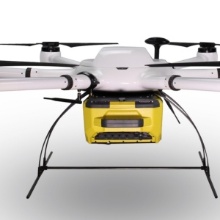Landfills emit greenhouse gases such as methane into the air via their surface. A new remote sensing method developed by an Institute of the Faculty now makes it possible to record the concentration of emissions more comprehensively and to model their propagation more precisely. The technology consists of a heavy-duty drone and an infrared measuring method known as Fourier transform spectroscopy (FTIR). It can be used for a wide range of climate-relevant gases and also in other areas of application, for example biogas or composting plants, livestock farms and even the measurement of reservoirs.
Climate-relevant gases such as methane, nitrous oxide or carbon dioxide enter the environment in a wide range of processes and from a variety of sources, for example through landfills or biogas plants. In order to be able to carry out climate protection measures in a targeted and effective manner, the pollutant values were previously recorded in the context of selective measurements in the plant itself or at measurement points on the slipstream side of the plant and extrapolated to the total emissions. However, such measurements are random and therefore inaccurate.
"What we need is a measuring method that allows us to record and model the plume at all heights and under different wind conditions," explain Imke Wessel and Martin Reiser from the Institute for Sanitary Engineering, Water Quality and Solid Waste Management at the Faculty. With the combination of a drone and coupled Fourier transform spectroscopy (FTIR), the Stuttgart researchers have now come a good deal closer to this goal. The new measuring system can be carried flexibly to any point at a variable height and orbit one or more emission sources. This enables a targeted and detailed measurement of the waste gas plume itself and the background concentrations. In addition, the measurement flights are fast: two to three hours on a few days a year are sufficient.
The system was made possible by two innovations: Firstly, the carrying capacity of heavy-duty drones has increased further in recent times and secondly, a "full" FTIR weighing less than 10 kg has recently become available.
The drone is currently being used in a research project for "metrological verification of the success of climate protection projects at waste disposal sites" (MÜDSE), funded by the Ministry for the Environment, Climate and Energy of Baden-Württemberg. Further research will now clarify what adjustments need to be made in the modelling of gas dispersion and the calculation of the actual greenhouse gas emissions.
| Contact | Dipl.-Ing. Manuel Krauss, Institute for Sanitary Engineering, Water Quality and Solid Waste Management (ISWA), Bandtäle 2, 70569 Stuttgart, Germany, +49 711 685-63700, manuel.krauss@iswa.uni-stuttgart.de |
|---|



